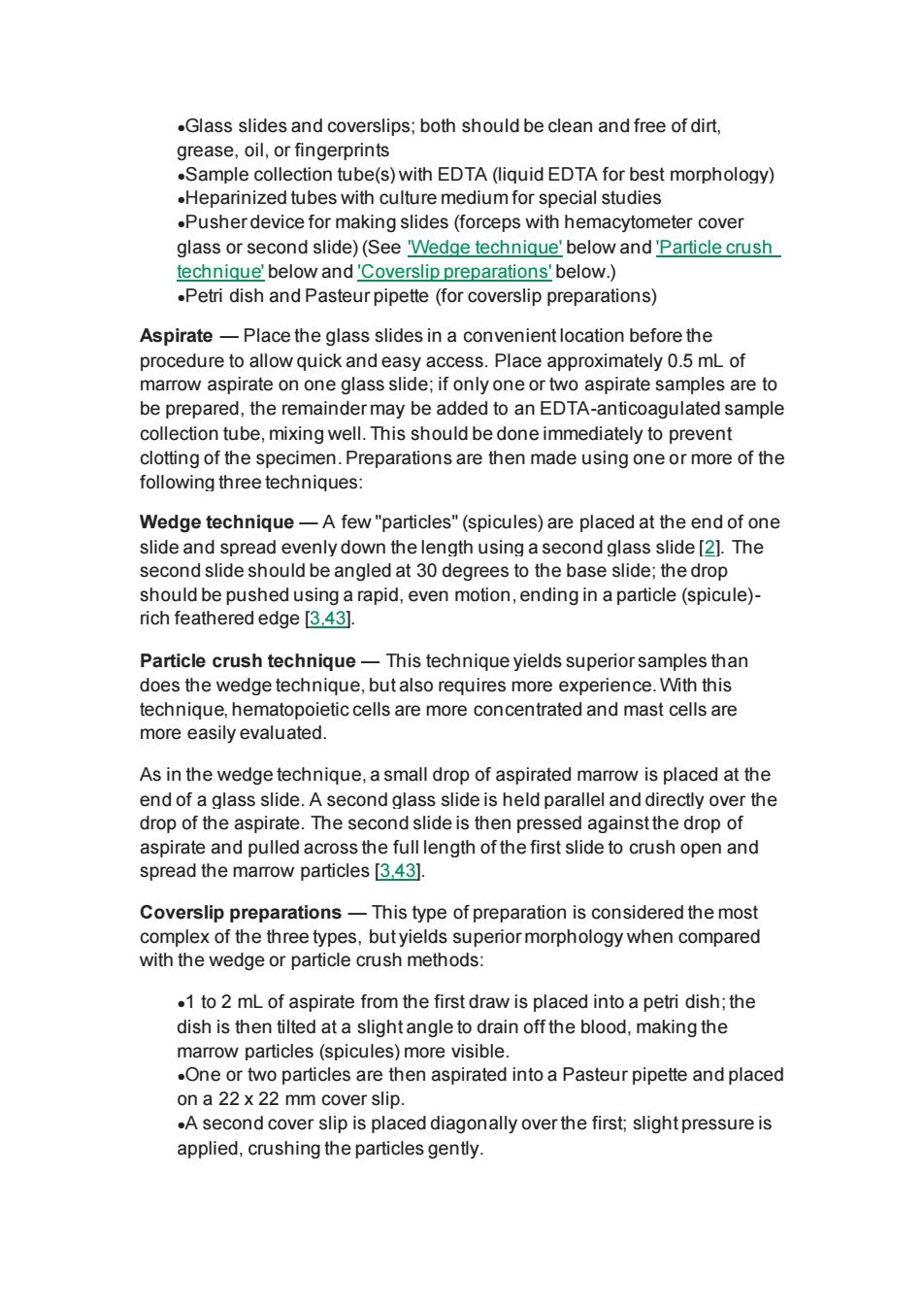正在加载图片...

.Glass slides and coverslips;both should be clean and free of dirt. grease oil,or fingerprints .Sample collection tube(s)with EDTA(liquid EDTA for best morphology) .Heparinized tubes with culture medium for special studies .Pusher device for making slides (forceps with hemacytometer cover alass or second slide)(See Wedae techniaue'below and 'Particle crush echnique'be and 'Cov esipreparations'below. .Petri dish and Pasteur pipette (for coverslip preparations) Aspirate -Place the alass slides in a convenient location before the proced ure to allow qu ick and easy a s.Plac e approx tely 0.5 mL of marrow aspirate on one glass slide;if only one or two aspirate sa mples are to be prepared,the remainder may be added to an EDTA-anticoagulated sample collection tube,mixing well.This should be done immediately to prevent clotting of the specimen.Preparations are then made using one or more of the following three techniques Wedge technique-A few"particles"(spicules)are placed at the end of one slide and spread evenly down the length using a second glass slide [2].The s to the base slide:the e pushed using a rapid,even motion,ending in a particle(spicule) rich feathered edge [3,43]. Particle crush technique. This technique yields superior sampl oles thar does the wedge technique.but also requires more experience.With this technique hematopoietic cells are more concentrated and mast cells are more easily evaluated. As in the wedge technique,a small drop of aspirated marrow is placed at the end of a glass slide.A second glass slide is held parallel and directly over the drop of the aspirate.the second slide is then pressed against the drop of aspirate and pulled across the full length of the first slide to crush open and sprea ad the e marrow particles [3.43]. Coverslip preparations-This type of preparation is considered the most elds su perior morphology when compared with the wedge or particle e crush methods .1 to 2 mL of aspirate from the first draw is placed into a petri dish;the dish is then tilted at a slight angle to drain off the blood.making the marrow particles (spicules)more visible .One or two particles are then aspirated into a Pasteur pipette and placed on a 22 x 22 mm cover slip. .A second cover slip is placed diagonally over the first;slight pressure is applied, crushing the part ticles gently●Glass slides and coverslips; both should be clean and free of dirt, grease, oil, or fingerprints ●Sample collection tube(s) with EDTA (liquid EDTA for best morphology) ●Heparinized tubes with culture medium for special studies ●Pusher device for making slides (forceps with hemacytometer cover glass or second slide) (See 'Wedge technique' below and 'Particle crush technique' below and 'Coverslip preparations' below.) ●Petri dish and Pasteur pipette (for coverslip preparations) Aspirate — Place the glass slides in a convenient location before the procedure to allow quick and easy access. Place approximately 0.5 mL of marrow aspirate on one glass slide; if only one or two aspirate samples are to be prepared, the remainder may be added to an EDTA-anticoagulated sample collection tube, mixing well. This should be done immediately to prevent clotting of the specimen. Preparations are then made using one or more of the following three techniques: Wedge technique — A few "particles" (spicules) are placed at the end of one slide and spread evenly down the length using a second glass slide [2]. The second slide should be angled at 30 degrees to the base slide; the drop should be pushed using a rapid, even motion, ending in a particle (spicule)- rich feathered edge [3,43]. Particle crush technique — This technique yields superior samples than does the wedge technique, but also requires more experience. With this technique, hematopoietic cells are more concentrated and mast cells are more easily evaluated. As in the wedge technique, a small drop of aspirated marrow is placed at the end of a glass slide. A second glass slide is held parallel and directly over the drop of the aspirate. The second slide is then pressed against the drop of aspirate and pulled across the full length of the first slide to crush open and spread the marrow particles [3,43]. Coverslip preparations — This type of preparation is considered the most complex of the three types, but yields superior morphology when compared with the wedge or particle crush methods: ●1 to 2 mL of aspirate from the first draw is placed into a petri dish; the dish is then tilted at a slight angle to drain off the blood, making the marrow particles (spicules) more visible. ●One or two particles are then aspirated into a Pasteur pipette and placed on a 22 x 22 mm cover slip. ●A second cover slip is placed diagonally over the first; slight pressure is applied, crushing the particles gently